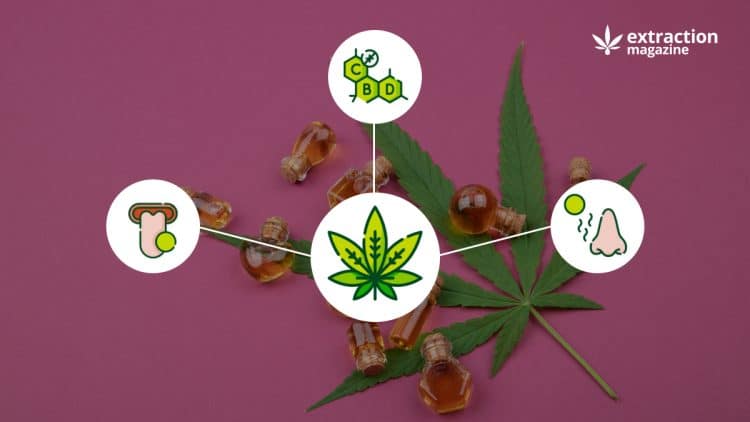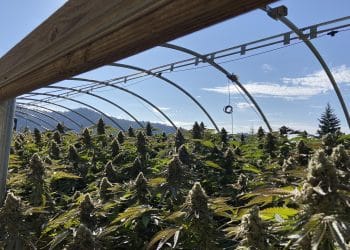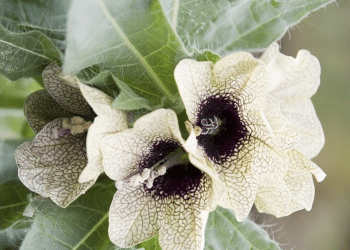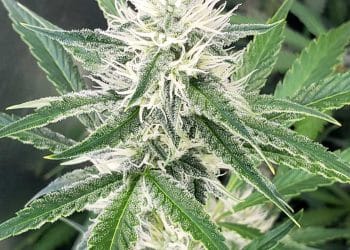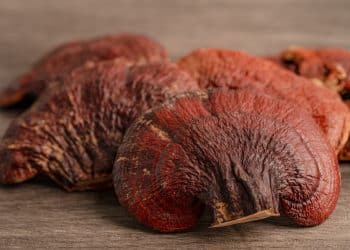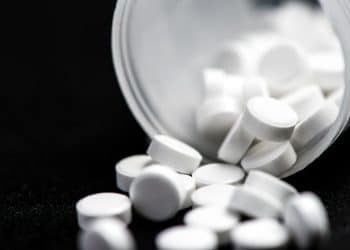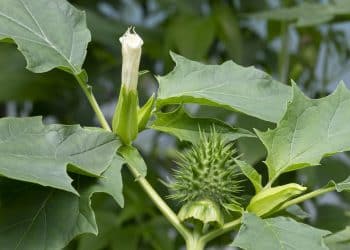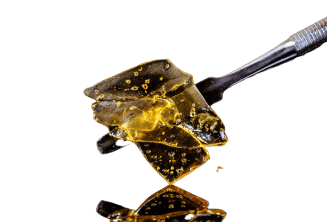Cannabis is a complex plant rich in beneficial chemical entities. More than 480 components have been identified among the three most interesting classes of cannabis secondary metabolites: cannabinoids, terpenes and phenolic compounds.
The former are widely known as the main constituents of cannabis, participating in the endocannabinoid system activation and potentially modulating many physiological effects. Among cannabinoids, cannabidiol (CBD) and the psychotropic tetrahydrocannabinol (THC) are the most studied.
Some terpenes and phenolic compounds such as flavonoids are known to modify cannabinoids’ properties and interact with them, leading to a wide range of pharmacological effects observed depending on the different cannabis variety.
Terpenes constitute the scent and aroma of cannabis plants and evidence suggest that they can potentially enhance the penetration of cannabinoids through skin layers or induce a beneficial effect themselves or in combination with other cannabis constituents.
The most well-known classes of phenolic compounds present in cannabis plants are:
- Flavonoids;
- Stilbenes;
- Phenolic acids;
- Lignans;
- Tannins.
Phenolic compounds are particularly known for their antioxidant properties and their extraction maintaining the biological activity is becoming a widely applied practice.
Phenolic compounds
These secondary metabolites contain benzene rings with one or more hydroxyl substituents and range from simple molecules to increasingly polymerized ones.
Plant phenolics are usually involved in the protection of the plant from UV light, predators and parasites, in addition to being responsible for the plant’s colors.
Phenolic compounds are involved in the plant defense mechanism, but they are also responsible for the attractive colors to facilitate pollination by insects or to exert antibacterial and antifungal action.
The main functions of phenolic compounds for plants are listed below:
- Protection from UV light;
- Protection from insects;
- Protection from predators;
- Attract pollinators and accelerate plant pollination process;
- Antibacterial (tannins);
- Antifungal;
- Signal compounds.
In terms of beneficial physiological effects for humans, phenolic compounds are widely extracted and researched for their action as anti-inflammatory, anti-oxidant, anti-proliferative and anti-aging agents.
The introduction of phenolic compounds in the human diet comes from fruits, vegetables and beverages consumption. These dietary antioxidants are a valuable support to humans health and they might protect against oxidative illnesses.
Phenolic compounds are well known for a wide range of applications including the complementary treatment of diseases such as diabetes, obesity and cancer among others.
Some important biological activities of phenolic compounds are summarized below:
- Antioxidant activity;
- Antiradical activity;
- Anti-inflammatory activity;
- Antibacterial activity;
- Neuroprotective potential;
- Antidiabetic;
- Anticholinergic;
- Antiepileptic.
Flavonoids
This class of chemical entities is one of the most diverse among phenolic compounds. In nature it is possible to find various flavonoids including: anthocyanins, flavones, flavonols, flavanones, isoflavones, flavanonols, and other subclasses.
Flavonoids play crucial roles for plants protection from UV light and insects or predators. Nevertheless some classes of them such as anthocyanins function as attractants for pollinators being responsible for flower coloration.
From a therapeutic point of view, many studies on their potential health benefits have been associated with treatment of diseases such as hypertension, cancer and intestinal health. Moreover flavonoids such as anthocyanins have been shown to protect against cardiovascular diseases and to prevent or potential treat obesity and diabetes.
Cannabis flavonoids
More than 20 flavonoids have been identified in cannabis.
It is estimated that more than 10% of cannabis contistuents are flavonoids with up to 3% by weight in dried leaves and buds. [6]
Among the most abundant there are flavone (apigenin and luteolin) and flavonol (kaempferol and quercetin) aglycones and glycosides.
Cannflavin A, B and C are prenylated/geranylated flavonoids mainly and almost uniquely reported in the cannabis genus, except for their presence in a plant of the Phrymaceae family.
Cannflavins A and B have been studied for their potential application as anti-inflammatory agents because of their ability to inhibit prostaglandin E production in vitro.
Moreover emerging data are starting to describe cannflavin-induced therapeutic benefits with potential clinical relevance in terms of antioxidant activity, anti-inflammatory action and analgesic and neuroprotective potential.
While flavonoids are undetectable in cannabis roots and seeds, they are ubiquitous in the rest of plant’s tissues such as leaves, flowers, fruits and also seedlings. Their concentration varies depending on the plant’s growing stage and their production can be enhanced or reduced upon environmental factors such as humidity, drought, solar radiation, temperature etc.
The bioactivity of cannflavin and other flavonoids makes them desirable by-products of the cannabinoids extraction process. Genetic studies have been made to enhance the expressions of genes encoding flavonoids in order to increase their concentration in cannabis plants. Nevertheless more studies and experiments are needed in order to fully understand their complex metabolic network and biosynthetic pathway.
Flavonoids could contribute to the synergistic action of cannabis constituents such as cannabinoids and terpenes to exert together the potential therapeutic properties of the plant. More studies should be done on this interaction called ‘’entourage effect’’, in order to fully understand the subtle variations on activities of cannabis phytochemicals.
Extraction Methods of phenolic compounds
To extract phenolic compounds from plants, fruits, barks and vegetables many techniques have been developed. The right choice of the extraction procedure is crucial in order to maximize flavonoids concentration in the final extract and to improve their stability and extraction efficiency.
Among the most used techniques to extract phenolic compounds there are:
- Solid-liquid extraction (SLE);
- Ultrasound-assisted extraction (UAE);
- Microwave-assisted extraction (MAE);
- Supercritical fluid extraction (SFE);
- Pressurized liquid extraction;
- Enzyme-assisted extraction.
Polar flavonoids can be extracted with aqueous and pure alcohols such as methanol or ethanol. Apolar flavonoids such as isoflavones, flavanones, flavones, and flavonols have affinity to solvents such as chloroform, dichloromethane, diethyl ether, and ethyl acetate.
Advanced techniques and strategies are continually being developed to overcome the limitations of conventional methods such as maceration, percolation, hydro-distillation, boiling, reflux, soaking, and Soxhlet extraction for the isolation of these compounds.
Modern extraction techniques such as SFE involve the use of solvents such as carbon dioxide (CO2) to selectively extract flavonoids from plant or fruit matrices improving the phenolic compounds concentration and quality in the final extract.
Many studies are still performed in order to reduce the extraction costs, the large amount of solvents used in traditional methods, the flavonoids thermal degradation, the long extraction times and low selectivity.
References:
- ElSohly, M.A.; Slade, D. Chemical constituents of marijuana: The complex mixture of natural cannabinoids. Life Sci. 2005, 78, 539–548. https://pubmed.ncbi.nlm.nih.gov/16199061/;
- Lin D, Xiao M, Zhao J, Li Z, Xing B, Li X, Kong M, Li L, Zhang Q, Liu Y, Chen H, Qin W, Wu H, Chen S. An Overview of Plant Phenolic Compounds and Their Importance in Human Nutrition and Management of Type 2 Diabetes. https://pubmed.ncbi.nlm.nih.gov/27754463/;
- Balasundram N., Sundram K., Samman S. Phenolic compounds in plants and agri-industrial by-products: Antioxidant activity, occurrence, and potential uses. Food Chem. 2006 https://www.sciencedirect.com/science/article/abs/pii/S0308814605006242;
- Zhang Y, Cai P, Cheng G, Zhang Y. A Brief Review of Phenolic Compounds Identified from Plants: Their Extraction, Analysis, and Biological Activity. Natural Product Communications. 2022;17(1). https://journals.sagepub.com/doi/full/10.1177/1934578X211069721;
- Taslimi P, Caglayan C, Gulcin I. The impact of some natural phenolic compounds on carbonic anhydrase, acetylcholinesterase, butyrylcholinesterase, and -glycosidase enzymes: an antidiabetic, anticholinergic, and antiepileptic study. J Biochem Mol Toxicol. 2017;31(12):e21995 https://pubmed.ncbi.nlm.nih.gov/28902458/;
- ACS Omega 2021, 6, 8, 5119–5123, 2021, https://pubs.acs.org/doi/10.1021/acsomega.1c00318;
- Salem, M. M.; Capers, J.; Rito, S.; Werbovetz, K. A. Antiparasitic activity of C-geranyl flavonoids from Mimulus bigelovii. Phytother. Res. 2011, 25, 1246– 1249, DOI: 10.1002/ptr.3404 https://pubmed.ncbi.nlm.nih.gov/21796699/;
- Barrett, M.L.; Gordon, D.; Evans, F.J. (1985). “Isolation from cannabis sativa L. Of cannflavin—a novel inhibitor of prostaglandin production”. Biochemical Pharmacology. 34(11): 2019–2024. https://pubmed.ncbi.nlm.nih.gov/3859295/;
- Rodríguez De Luna SL, Ramírez-Garza RE, Serna Saldívar SO. Environmentally Friendly Methods for Flavonoid Extraction from Plant Material: Impact of Their Operating Conditions on Yield and Antioxidant Properties. ScientificWorldJournal. 2020 Aug 28;2020:6792069. doi: 10.1155/2020/6792069. https://www.hindawi.com/journals/tswj/2020/6792069/;
- Ferreira O., Pinho S. P. Solubility of flavonoids in pure solvents. Industrial & Engineering Chemistry Research. 2012;51(18):6586–6590. doi: 10.1021/ie300211e. https://pubs.acs.org/doi/10.1021/ie300211e;
- Front. Chem., 25 September 2020 Sec. Green and Sustainable Chemistry Volume 8 – 2020 | https://doi.org/10.3389/fchem.2020.507887 https://www.sciencedirect.com/science/article/pii/S2589004221014607.
